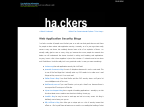February 2008
Gnu Privacy Guard tutorial, part 1 || kuro5hin.org

Automated security updates in Debian « N0T a Blog
by 3 others (via)
SignServer 3.0 - Home
(via)January 2008

Welcome to REMO | REMO - Rule Editor for ModSecurity
(via)
Jeremiah Grossman: New Flash XSS technique (thousands of websites at risk)
(via)December 2007

Suhosin 0.9.21 - XSS Protection - PHP Security Blog
November 2007
September 2007

PHPIDS » Web Application Security 2.0 » Index
by 1 other (via)August 2007

GreenSQL - Open Source Database Firewall Solution
by 4 others
The Usability of Passwords - Baekdal.com
by 5 others (via)July 2007

Chris Shiflett: CSRF Redirector

XSS post forwarder
by 1 other (via)0x000000 ◊ The Hacker Webzine
June 2007

XSS (Cross Site Scripting) Cheat Sheet
by 17 others (via)
HTML Purifier - Filter your HTML the standards-compliant way!
by 18 othersMarch 2007

Beginner's guide to OpenID phishing
by 2 others (via)
Dangers of CSRF and XSS / Articles / Community
by 1 other (via)February 2007

ha.ckers.org web application security lab - Archive » Web Application Security Blogs
(via)January 2007

MySQL: Storing Passwords in MySQL
by 2 others (via)December 2006

BindShell.Net: BeEF
October 2006

opensso: Home
by 1 other (via)
PHP Security Consortium: PHPSecInfo
by 8 others (via)
Checklist for Securing PHP Configuration | Ayman Hourieh's Blog
by 3 others (via)


